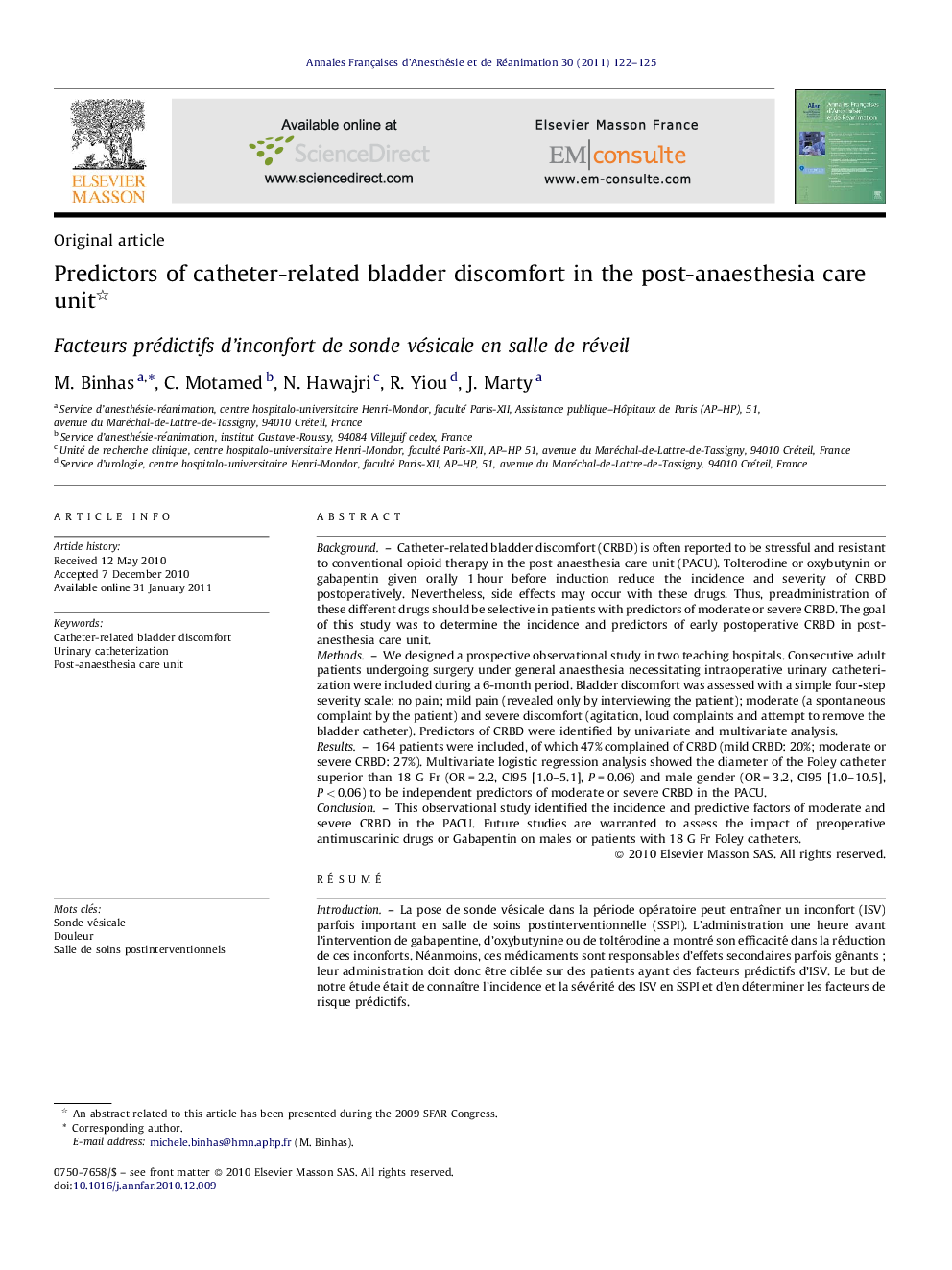| کد مقاله | کد نشریه | سال انتشار | مقاله انگلیسی | نسخه تمام متن |
|---|---|---|---|---|
| 2746537 | 1148879 | 2011 | 4 صفحه PDF | دانلود رایگان |

BackgroundCatheter-related bladder discomfort (CRBD) is often reported to be stressful and resistant to conventional opioid therapy in the post anaesthesia care unit (PACU). Tolterodine or oxybutynin or gabapentin given orally 1 hour before induction reduce the incidence and severity of CRBD postoperatively. Nevertheless, side effects may occur with these drugs. Thus, preadministration of these different drugs should be selective in patients with predictors of moderate or severe CRBD. The goal of this study was to determine the incidence and predictors of early postoperative CRBD in post-anesthesia care unit.MethodsWe designed a prospective observational study in two teaching hospitals. Consecutive adult patients undergoing surgery under general anaesthesia necessitating intraoperative urinary catheterization were included during a 6-month period. Bladder discomfort was assessed with a simple four-step severity scale: no pain; mild pain (revealed only by interviewing the patient); moderate (a spontaneous complaint by the patient) and severe discomfort (agitation, loud complaints and attempt to remove the bladder catheter). Predictors of CRBD were identified by univariate and multivariate analysis.Results164 patients were included, of which 47% complained of CRBD (mild CRBD: 20%; moderate or severe CRBD: 27%). Multivariate logistic regression analysis showed the diameter of the Foley catheter superior than 18 G Fr (OR = 2.2, CI95 [1.0–5.1], P = 0.06) and male gender (OR = 3.2, CI95 [1.0–10.5], P < 0.06) to be independent predictors of moderate or severe CRBD in the PACU.ConclusionThis observational study identified the incidence and predictive factors of moderate and severe CRBD in the PACU. Future studies are warranted to assess the impact of preoperative antimuscarinic drugs or Gabapentin on males or patients with 18 G Fr Foley catheters.
RésuméIntroductionLa pose de sonde vésicale dans la période opératoire peut entraîner un inconfort (ISV) parfois important en salle de soins postinterventionnelle (SSPI). L’administration une heure avant l’intervention de gabapentine, d’oxybutynine ou de toltérodine a montré son efficacité dans la réduction de ces inconforts. Néanmoins, ces médicaments sont responsables d’effets secondaires parfois gênants ; leur administration doit donc être ciblée sur des patients ayant des facteurs prédictifs d’ISV. Le but de notre étude était de connaître l’incidence et la sévérité des ISV en SSPI et d’en déterminer les facteurs de risque prédictifs.Méthodesétude prospective, descriptive sur six mois dans deux centres auprès de patients consécutifs bénéficiant d’une anesthésie générale pour une chirurgie urologique, digestive ou périphérique et sondés en peropératoire. Le but consistait à déterminer l’incidence des inconforts de sonde et leur intensité (inconfort absent, faible = gêne à l’interrogatoire sans plainte spontanée, modéré = plainte spontanée sans agitation, sévère = plainte spontanée + agitation du patient). Les facteurs prédictifs d’inconfort modéré ou sévère étaient recherchés par une analyse uni- et multivariée.RésultatsCent soixante-quatre patients ont été analysés (age moyen 61ans). Quarante-sept pour cent se sont plaints en SSPI d’ISV (27% d’ISV modérés ou sévères). L’analyse multivariée a retrouvé comme facteurs prédictifs d’ISV modéré ou sévère un diamètre de sonde vésicale supérieur ou égal à 18 G Fr (OR = 2,2 CI95 [1,0–5,1], p = 0,06) et le sexe masculin (OR = 3,2 IC95 [1,0–10,5], p < 0,06).DiscussionLes ISV sont fréquents en SSPI (près d’un patient sur deux), ils sont modérés ou sévères chez plus d’un patient sur quatre. Un diamètre élevé de la sonde (≥ 18 G Fr) et le sexe masculin sont prédictifs d’ISV modérés ou sévères en SSPI.
Journal: Annales Françaises d'Anesthésie et de Réanimation - Volume 30, Issue 2, February 2011, Pages 122–125